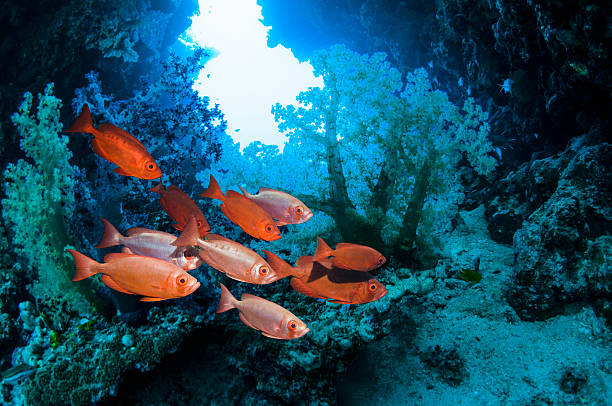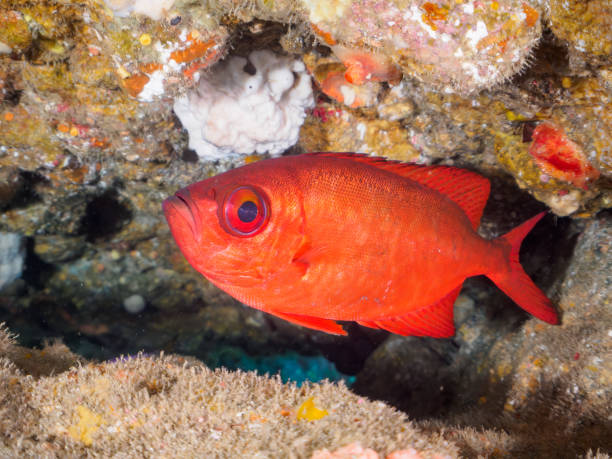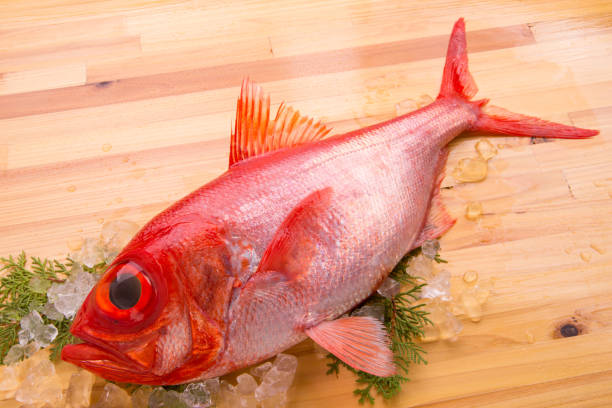Table of Contents
Scientific Classification
| Kingdom | Animalia |
| Phylum | Chordata |
| Class | Actinopterygii |
| Order | Beryciformes |
| Family | Berycidae |
| Genus | Beryx |
| Species | Beryx decadactylus |
| Scientific Name | Beryx decadactylus |
Description
The Alfonsino (Beryx decadactylus) is a fascinating deep-sea fish known for its vibrant red skin and large, gleaming eyes. These eyes are adapted to help it navigate the dark depths of the ocean. With a long, flat body that has a shiny silver appearance, the Alfonsino is quite distinctive. Typically, it grows to about 50 cm (20 inches) in length, although some individuals can reach up to 70 cm (28 inches).
The fish is covered in large, rough scales and features a prominent dorsal fin along with a deeply forked tail that aids in its movement. Living in deep waters, their eyes are highly sensitive to light, allowing them to detect movement even in near darkness.

Distribution
Alfonsino are found in deep waters across the world’s oceans, with a preference for tropical and temperate regions. They are commonly located in:
The Atlantic Ocean – Ranging from North America to Europe and parts of Africa.
The Indian Ocean – Especially near the coasts of South Africa and India.
The Pacific Ocean – Present near Japan, Australia, and New Zealand.
These fish typically inhabit continental slopes, seamounts, and underwater ridges, often residing at depths between 200 to 1,200 meters (650 to 3,900 feet).
Habitat
Alfonsino are mainly found in deep-sea habitats, typically close to the ocean floor or in the mid-water column. They tend to reside near seamounts and other deep underwater formations, where they can access both shelter and food. These fish prefer cooler waters that are rich in oxygen, often following ocean currents that deliver nutrient-rich upwellings.
Living in conditions of extreme pressure and low light, Alfonsino have developed unique adaptations. They possess enhanced vision and are capable of thriving in high-pressure environments.
Diet
Alfonsino are opportunistic predators that mainly consume:
Small fish – This includes lanternfish and juvenile varieties of other deep-sea fish.
Crustaceans – They feed on shrimp, krill, and deep-water amphipods.
Cephalopods – Squid and small octopuses constitute a significant portion of their diet.
Behavior
Alfonsino inhabit deep waters, yet they are quite active swimmers and frequently come together in small groups. Their behavior includes:
Nocturnal Feeding – They tend to feed more during the night when it’s easier to locate prey.
Vertical Migration – Certain groups migrate to shallower waters at night for hunting, returning to deeper areas during the day.
Younger Alfonsino typically school together, while adults usually prefer a solitary lifestyle or form loose associations.
Lifespan
Alfonsino fish live a long time, up to 15 to 20 years in the wild. This is longer than many other fish species. Their slow growth helps them live long, but it also makes them easy targets for overfishing.
Reproduction and Lifecycle
Alfonsino have a reproductive cycle that is characteristic of deep-sea fish:
Spawning Season – This typically takes place during the warmer months, depending on the geographic area.
Egg Development – The eggs are buoyant and float in open water until they hatch.
Larval Stage – Young Alfonsino start their lives in shallow waters, where they have access to more food and encounter fewer predators.
Maturity – They achieve reproductive maturity between the ages of 5 to 7 years.
The Alfonsino has a slow reproduction rate, which means that its populations take longer to recover after being depleted.
Predators
Adult Alfonsino have few natural predators due to their deep-sea habitat. Nonetheless, they still encounter threats from:
Larger predatory fish – This includes deep-sea sharks and sizable tuna species.
Marine mammals – Such as deep-diving whales that hunt in their environment.
Humans – Commercial fishing poses a significant threat to their populations.
Adaptations
To thrive in the deep-sea environment, Alfonsino have evolved several key adaptations:
Large Eyes – Highly sensitive to detect movement in near-total darkness.
Compressed Body – Helps them maneuver efficiently in deep-sea currents.
Slow Metabolism – Conserves energy in food-scarce environments.
Vertical Migration Ability – Allows them to exploit food resources at different depths.
These adaptations help Alfonsino live in one of Earth’s toughest environments.
Conservation Status
The IUCN currently lists Alfonsino as Least Concern for conservation status. Deep-sea trawlers and longline fisheries mainly catch them in the Atlantic and Pacific.
Threats:
- Overfishing – They grow slowly and reproduce less, so they’re at risk from too much fishing.
- Bycatch – Frequently caught unintentionally in deep-sea fishing operations.
- Habitat Destruction – Damage to seamounts and deep-sea ecosystems affects their populations.
Conservation Efforts:
Fishing Regulations – Some regions have imposed quotas to prevent overfishing.
Marine Protected Areas (MPAs) – Efforts to safeguard critical habitats.
Sustainable Fishing Practices – Encouraging the use of less destructive fishing methods.
We need more research to support Alfonsino populations and their deep-sea habitats.
Conclusion
The Alfonsino is a fascinating deep-sea fish that plays an important role in the ocean’s food chain. Its capacity to thrive in the depths and its striking appearance demonstrate its remarkable adaptation to deep-sea life. Unfortunately, human activities, especially overfishing, are increasingly threatening its populations. It is essential to protect this unique species for future generations. We must implement effective conservation strategies and promote sustainable fishing practices.



